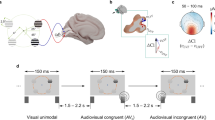Summary
Visual evoked potentials in response to contrast reversal of grating patterns were used as a measure of visual function in normal and visually deprived cats. In cats which had been dark reared from birth (BD cats) there was a characteristic change in VEP waveform from normal, for both eyes and for all spatial frequencies of testing stimulus. In cats which had one eye sutured from the age of one week (MD cats), the VEP from the deprived eye was smaller for contrast reversal of coarse patterns. Kittens given only restricted periods of monocular exposure gave VEPs which resembled the pathological responses of the BD cats. However, the amplitudes of response were larger for the more experienced eye at higher spatial frequency. This work reinforces the idea that two factors govern cortical development: competition and experience. Lack of sufficient visual experience leads to severe intracortical pathology.
Similar content being viewed by others
References
Blakemore, C.B., Sluyters, R. van: Innate and environmental factors in the development of the kitten's visual cortex. J. Physiol.248, 663–716 (1975)
Campbell, F.W., Maffei, L.: Electrophysiological evidence for the existence of orientation and size detectors in the human visual system. J. Physiol.207, 635–652 (1970)
Campbell, F.W., Maffei, L., Piccolino, M.: The contrast sensitivity of the cat. J. Physiol.229, 719–731 (1973)
Cooper, G.F., Robson, J.G.: Successive transformations of spatial information in the visual system. I.E.E./N.P.L. Conference on Pattern Recognition, I.E.E. Conference Publ.47, 134–143 (1968)
Cornwell, A.C.: Modifiability of retinal activity in visually deprived kittens. Vision Res.14, 1223–1227 (1974)
Guillery, R.W.: Binocular competition in the control of geniculate cell growth. J. Comp. Neurol.144, 117–130 (1972)
Halliday, A.M., McDonald, W.I., Muskin, J.: The visual evoked response in the diagnosis of multiple sclerosis. Br. Med. J.4, 661–664 (1973)
Hubel, D.H., Wiesel, T.N.: Receptive fields, binocular interaction, and functional architecture in the cat's visual cortex. J. Physiol.160, 106–154 (1962)
Maffei, L., Fiorentini, A.: The visual cortex as a spatial frequency analyzer. Vision Res.13, 1255–1267 (1973)
Peck, C.K., Blakemore, C.B.: Modification of single neurons in the kitten's visual cortex after brief periods of monocular visual experience. Exp. Brain Res.22, 57–68 (1975)
Shapley, R.M., Rossetto, M.: An electronic visual stimulator. Behav. Sci. Res. Meth. Instrum.8, 15–20 (1976)
Sherman, S.M.: Visual development in cats. Investig. Ophth.11, 394–401 (1972)
Snyder, A.: The effects of visual deprivation on pattern-related cortical evoked potentials. Thesis, The Rockefeller University (1977)
Spekreijse, H., Khoe, L., Tweel, L.H. van der: A case of amblyopia: electrophysiology and psychophysics of luminance and contrast. In: The visual system (ed. Arden), pp. 141–156. New York: Plenum Press 1972
Wiesel, T.N., Hubel, D.H.: Comparison of the effect of unilateral and bilateral eye closure on cortical unit responses in kittens. J. Neurophysiol.28, 1029–1040 (1965)
Author information
Authors and Affiliations
Rights and permissions
About this article
Cite this article
Snyder, A., Shapley, R. Deficits in the visual evoked potentials of cats as a result of visual deprivation. Exp Brain Res 37, 73–86 (1979). https://doi.org/10.1007/BF01474255
Received:
Issue Date:
DOI: https://doi.org/10.1007/BF01474255



